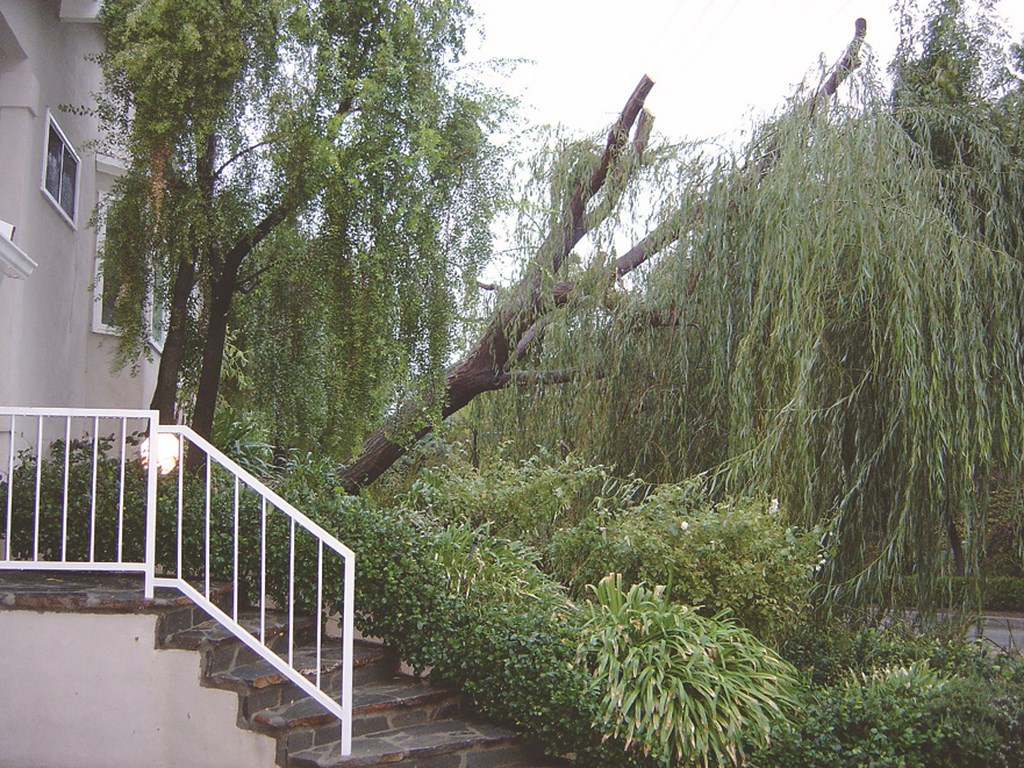Nature’s Way

Throughout my design career, I have repeatedly expressed to clients that their gardens are dynamic, constantly changing and only to a very minimal degree under anyone’s control. You can plant, water, fertilize, cultivate and prune – “and if you’re lucky,” I say, “you’ll enjoy the fruits of your labors in the form of a visual feast.”
But that’s only if you’re lucky, I continue, because no matter what we do to nurture gardens, they are always subject to the whims of Mother Nature. From the smallest annual to the most statuesque tree, no garden is immune.
Even though I’ve always had this talk with clients, however, I’ve always held the mild belief that it’s possible in some ways to stay a step ahead of her by being vigilant and active. I learned the other day at first hand that she still has the upper hand.
CRYING TIME
When my daughter was born 12 years ago, I planted a 15-gallon Weeping Willow in the front yard. I’ve always admired the graceful sway of these beautiful trees, no matter the season, and I’ve always loved this tree in particular for obvious sentimental reasons.
The tree thrived and grew to about 30 feet, at which point I started trimming it back to keep it away from the power lines and its main branches at a safe distance from my house. I also had my tree trimmer stop by at least once a year to lighten up the leaves so light could get to the plants below and the tree wouldn’t get too heavy.
Everyone in the neighborhood loved that tree, too, but note the past tense: The willow didn’t make it through the first major storm of the 2004-05 season.
Weighed down by water and whipped by the wind, the tree gave way. We saw five terrifying arcs of electrical current light up the entire street as the branches first touched the power lines and watched helplessly as the tree caught fire and the downed power lines continued to spark.
| The fallen tree looks graceful even in its demise, but it caused a good bit of neighborhood trouble on its way down – and taught some valuable lessons at the same time. |
Before long, the Fire Department arrived, the power was off and it was safe to go outside to survey the damage, and I knew it was all over for my tree. It occurred to me as I stood there that, no matter how well I had cared for the tree through the years, it was somehow destined to meet this particular fate.
After calling neighbors to apologize for a power outage in the middle of one of the bigger October storms we’ve experienced in many years, I called my tree trimmer, said a few words over the limbs of a fallen comrade and, callous as it may seem, started almost immediately to think about replacing it.
Looking out over my front yard and a mostly destroyed landscape, I can only smile at the irony: I’m the landscape designer with the best looking yard on the block, yet I’m the one who wreaked havoc on the entire neighborhood with my handiwork!
Irony aside, there were serious lessons to be learned here.
BASIC TRUTHS
Through all my ponderings on the misfortunate willow, I saw that our clients need to:
* know that we will design beautiful landscapes for them that will require their constant attention – or the attention of a qualified professional.
* accept the fact that all the constant attention in the world cannot guarantee that the landscape will look exactly the way they want it to look.
* recognize that, when push comes to shove, Mother Nature’s hand trumps all others, no matter how many cards we might have up our sleeves.
* know that, although we can’t fight Mother Nature, there are still things we can do to minimize her effects.
The thought that the best offense is a good defense applies just as easily to a garden as it does to anything else: By taking good care of our gardens, we create the healthiest environments we can and engender an integrity that becomes their own best defense against the forces of nature. It’s just like taking good care of your health: If you exercise, eat right and get enough sleep, you have a better chance of fighting off illness than if you become a couch potato.
So what are some things you can suggest by way of minimizing the potential damaging effects of Mother Nature? Here are a few points to consider:
[ ] Have an arborist examine all trees on the property once a year and, if he or she diagnoses tree diseases or other abnormalities and makes suggestions for treatment, make sure your clients heed that advice. Arborists will typically set up programs to visit, diagnose and treat trees on a regular basis, even setting up schedules so nobody needs to think much about it. To find one, start with the Yellow Pages, check for certification and do what you can to find a professional who is familiar with the given area. [ ] Make certain that all trees and shrubs are pruned on a regular basis. Beyond routine maintenance, it’s important to have a gardener or specialty maintenance crew come in once or twice a year (ideally during May and October) to shape, prune, thin and otherwise care for plants that may overgrow or create hazards. [ ] Thin out larger trees. As we look up at large trees, it’s tough to assess just how much weight is carried on those branches. A good, wind-assisted rainstorm multiplies that weight many times and creates a significant potential for broken branches or, as in my case, a fallen tree. [ ] If something looks abnormal on your client’s plants and trees, something has probably gone wrong. Not long before the storm, for example, I’d noticed that my Weeping Willow was leaning a bit and that the base of its trunk had a knotty/gnarled appearance – a syndrome I later learned was probably a disease called “crown gall.” Although there was nothing I could have done to save my tree, there is always a chance of staking a sickly tree or cutting it way back so that it doesn’t become a hazard. Removal may still be necessary, but you don’t want to have that become a foregone conclusion during a rainstorm. [ ] Keep trees well away from power lines and low enough relatively so that if they do fall, they will fall harmlessly. Even though mine was trimmed away from the lines, it was tall enough in other parts that it caught two or three of the six lines in its path on the way down. Keeping heights down also minimizes the amount of tree standing up against the elements and, once again, lowers the probability of damage in a storm. [ ] Select appropriate plants for the general weather patterns in your area. Putting a large, heavy tree in a small yard that frequently experiences high wind conditions, for example, is probably not a good bet. I’d even recommend consulting an arborist on tree choices before making final selections. In my area, for example, oak-root fungus is rampant, causing trees to die quite quickly and often without warning. It’s enough of an issue that I now routinely check with an arborist to make sure that trees I’ve selected are truly suited to their locations. [ ] Keep a sense of humor through thick and thin. As sentimentally attached as I was to my willow, I had no choice once it fell other than to let go and move on. My daughter wants me to plant another Weeping Willow; I’m reluctant to do so at this point, but I’m convinced I’d know how to take better care of one the next time around.As I write this column, I can’t help thinking about how much I loved that tree and appreciated the visual beauty to which it had treated me year after year as I looked out the window of my home office. I’m happy that I had spent all that time enjoying its simple beauty because, after all, you never know when Mother Nature will let you know who’s really in charge.
Stephanie Rose wrote her Natural Companions column for WaterShapes for eight years and also served as editor of LandShapes magazine. She may be reached at [email protected].












